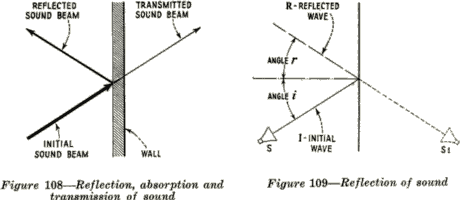Probably we can obtain a better mental picture of reverberation by using optical analogy
again. Let us imagine that we have a room with mirrored walls and both a source of sound
and light at the point S as in Figure 111. If an
observer is stationed at A he will see the object and hear the direct sound, not only at S but he will see
the images and hear the reflected sounds also from the image sources S1, S2, S3, and S4. These images
form the first reflections and are reflected again, and likewise the second images are reflected, forming a
new set of images. Obviously the successive images are farther and farther away so that the image the
farthest away would be the faintest in loudness. Optically, one stationed at A would see many images
of S in all directions.
The effect of reverberation is to cause blurred speech and music, due to the overlapping of the
successive syllables in speech. Up to a certain point this overlapping is apparently beneficial because it
increases the loudness of sound, but beyond this optimum point overlapping of successive syllables is
detrimental. Thus, there is a period of reverberation, depending on the size of the auditorium, which will
give optimum results. Although reverberation greater than the optimum value is detrimental, it is
tolerable if not excessive. Thus, there is a time of reverberation greater than the optimum period which
will give acceptable results. In general, the reverberation time should never be much greater than two
seconds.

The audience in any theatre causes the time of reverberation to vary, for each auditor absorbs a large
quantity of sound. It is therefore desirable to have optimum results obtained for the average size
audience and acceptable results for the minimum size audience entertained in the auditorium.
The reverberation time of a room, which is the time required for a sound of given initial intensity to die
away to the point where it is just barely audible, depends directly on the loudness of sound and the size
of the room, and depends inversely on the absorption in the room. The standard reverberation time of a
room is the reverberation time obtained when using an initial intensity of 1,000,000 times the intensity of
the faintest sound which can be heard. This represents a sound volume of six times the loudness of a
sound barely audible.
Increasing the size of a room increases the reverberation period due to the fewer number of reflections
which occur in it during a given space of time, although the total number of reflections remains
approximately the same.
4
